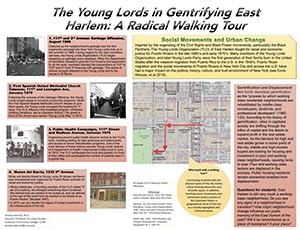Social Sciences
Case Study of Unlicensed Immigrant Latin@ Street Vendors in Los Angeles
This lesson by professor Amy Traver encourages students’ synthesis of various course concepts through a case study of unlicensed immigrant Latin@ street vendors in Los Angeles, CA. This module also introduces students to the research method of visual sociology. There are two goals: to encourage students’ organic use of the concepts in the module, and to facilitate students’ consideration of photography as a data collection method. Download Lesson
Ethnography of Work
In this lesson by Professor Lori Ungemah, Guttman Community College, students develop their literacy and analytic skills by reading and annotating an academic article about immigrant families and work, discussing ideas from the text, selecting specific quotes that speak to four different given topics, and in a “speed date/speed reading” activity, defend their selections to each other and compare interpretations, while reflecting on the articles concepts. Through the act of explaining their understandings to several of their peers, students engage in and reflect deeply on academic texts, while demonstrating their understanding verbally and in writing. Download Lesson
The Judiciary: Mexican-Americans, Civil Rights, and the Courts
Typically, the course is an overview of the theory, structure, institutions and processes of American Government, as well as public policy, civil liberties and civil rights. This lesson may be used in discussions about the federal judiciary and civil rights, as it illustrates how the federal judiciary can be understood in reference to the legal struggle of Latinos – Mexican Americans in particular – for equal rights in the U.S. Download Lesson
NAFTA and Migration: The Case of the Displaced Mexican Farmer
This lesson by Professor Peter Kolozi, Bronx Community College, may be used for an Introduction to American Government course. Typically, the course is an overview of the theory, structure, institutions and processes of American Government, as well as public policy, civil liberties, and civil rights. This lesson may be used in discussions about institutions, foreign policy, and civil rights. The lesson below illustrates how the institutions of the federal government can be taught with reference to the experiences of Latinos in the US and the Western Hemisphere. Download Lesson
Images of Resistance, Rebellion and Freedom
 This lesson by Marci Littlefield, Professor of Ethnic Studies at Borough of Manhattan Community College, CUNY, is designed to help students make the connection between the struggfle for rights of African Americans and Latinos. Using visual images to understand histories of rebellion and resistance, this posterboard serves as an introduction to a series of activities that utilize visual images and primary documents to help understand social structure, citizenship and labor exploitation and the concomitant effect on Latino and African Americans.
This lesson by Marci Littlefield, Professor of Ethnic Studies at Borough of Manhattan Community College, CUNY, is designed to help students make the connection between the struggfle for rights of African Americans and Latinos. Using visual images to understand histories of rebellion and resistance, this posterboard serves as an introduction to a series of activities that utilize visual images and primary documents to help understand social structure, citizenship and labor exploitation and the concomitant effect on Latino and African Americans.
Using Census Data to Explore New Jersey’s Hispanic Populations
 This active learning activity for an Introduction to Sociology course created by Gianna Durso-Finley, Professor of Sociology at Mercer County Community College, asks students to engage with U.S. Census data to explore Hispanic populations in New Jersey. Using Mercer College as the basis, students choose another county for comparison mapping. (See detailed instructions handout) Open-ended questions ask students to consider rural/urban issues, employment issues, gender issues, and what the diferences they found might mean both historically and for future trends. Students also explore the limits of this type of data and identify a topic of interest emerging from this mapping project that they could pursue through further research.
This active learning activity for an Introduction to Sociology course created by Gianna Durso-Finley, Professor of Sociology at Mercer County Community College, asks students to engage with U.S. Census data to explore Hispanic populations in New Jersey. Using Mercer College as the basis, students choose another county for comparison mapping. (See detailed instructions handout) Open-ended questions ask students to consider rural/urban issues, employment issues, gender issues, and what the diferences they found might mean both historically and for future trends. Students also explore the limits of this type of data and identify a topic of interest emerging from this mapping project that they could pursue through further research.
Download the lesson used in this presentation
The Young Lords in Gentrifying East Harlem: A Radical Walking Tour
 Inspired by the recently published “A People’s Guide to Los Angeles,” this walking tour by Andrea Morell, Professor of Urban Studies at Guttman Community College, CUNY, is one step in constructing an alternative tourist guide to New York City. This activity examines social movements and urban change in East Harlem that focuses on the Young Lords activism, Latino cultural institutions and gentrification. Special emphasize is given to old and new Latino neighborhoods.
Inspired by the recently published “A People’s Guide to Los Angeles,” this walking tour by Andrea Morell, Professor of Urban Studies at Guttman Community College, CUNY, is one step in constructing an alternative tourist guide to New York City. This activity examines social movements and urban change in East Harlem that focuses on the Young Lords activism, Latino cultural institutions and gentrification. Special emphasize is given to old and new Latino neighborhoods.
Changing the Narrative / Cambiando la Narrativa
This lesson plan was created by Danelle Bower as the initial piece to a classroom-based and community- grounded service learning project, embedded within an Introductory Sociology course. This service learning project was the outgrowth of collaboration with a community development corporation who, when asked how students could help, recommended that students explore ways in which they could contribute to the changing of the narrative of the City of Reading, PA. Download Lesson